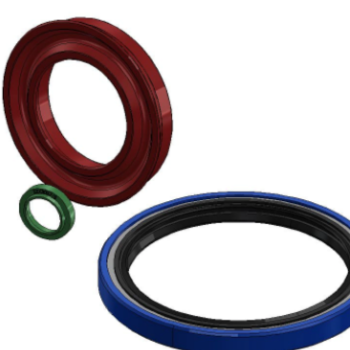Hydraulic Seals: How to Ensuring Efficiency and Reliability

Hydraulic Seals: How to Ensuring Efficiency and Reliability
Hydraulic systems rely on seals to contain high-pressure hydraulic fluids and maintain performance. Hydraulic seals prevent leaks, reduce friction, and precisely control and regulate hydraulic actuators, motors, and cylinders.
In this article, we will discuss the following topics:
- Principle of Hydraulic Seals
- Types of Hydraulic Seals
- usage, Benefits, and some Expected failures of Hydraulic Seals
Principle of Hydraulic Seals:
Hydraulic seals are gaskets used to seal gaps between hydraulic cylinder components. Hydraulic cylinders contain multiple interconnecting parts, some of which contact the fluid. Hydraulic seals prevent fluid from leaking around these parts.
Hydraulic seals are tailored to suit a hydraulic cylinder’s components while providing an airtight seal. Like O-rings, hydraulic seals have a groove that allows parts to fit in. To create an impermeable seal, the track envelops the part. The part will not leak even as the hydraulic cylinder’s piston moves and fluid pressure increases. The hydraulic seal contains the fluid within its proper chamber, avoiding spills around the part.
Hydraulic seals and O-rings resemble each other, but hydraulic seals have a groove in the lip to accommodate parts. By moving over the part, the track produces a leak-proof seal.
In summary, hydraulic seals are custom gaskets that maintain the hydraulic system’s integrity by sealing gaps between moving parts and containing the hydraulic fluid. They prevent spills and leaks that could damage components or reduce efficiency. Hydraulic seals and O-rings are essential for creating airtight seals in hydraulic systems.
Types of Hydraulic Seals:
There are many of types for hydraulic seals; here are some:
- Hydraulic Cylinder Seals: Cylinder seals seal openings within hydraulic cylinders. Their structure allows them to retain hydraulic fluids, exclude solid or liquid contaminants, and sustain hydraulic pressure. These functions demand various seal styles and traits that enhance performance.
- Lip Seal: Any seal’s lip design will vary based on its application. Many seals have what is referred to as “lips” as part of their design. This applies to radial, rotary, and linear shaft seals alike.
- Mechanical Seal: Mechanical seals are components utilized on rotating equipment like pumps and mixers to reduce leakage of liquids and gasses into the environment. They minimize leakage from the equipment into the surrounding atmosphere.
- Metric Oil Seal: Oil seals, which include grease seals, fluid seals, and dirt seals, refer to seals that cover spaces between fixed and moving mechanical parts. These seals serve several purposes. They prevent lubricants from leaking out of machinery, keep contaminants from entering mechanical systems, and isolate different mediums like oil and water from mixing, which are especially important under extreme operating conditions.
- Hydraulic Rod Seals: These are the most critical seals on any hydraulic equipment that keep fluid from leaking out of the cylinder to the outside environment.
- Rotary Seals: These are the most crucial seals on any hydraulic equipment that keep hydraulic fluid leakage from inside the cylinder to the outside environment.
- Hydraulic Rubber Seals: These products offer an ideal solution for reducing vibration and muting noise. The rubber seals come in various forms, including co-extruded bases with rubber bulb feet, ribbed profiles, lid seals, and triangular sections. They ensure effective vibration management and noise dampening.
Usage, Benefits, and Expected Failures of Hydraulic Seals:
In this part of the article, we’ll discuss the following:
The Uses of Hydraulic Seals: Hydraulic seals are used in several industrial applications, including:
- Automotive
- Off-highway
- Manufacturing
- Oil refineries
- Power transmission
The Benefits of Hydraulic Seals: Here are some benefits:
- They are intended to provide extended service life.
- A hydraulic seal can be replaced relatively briefly (minutes).
- Hydraulic seals can significantly reduce oil plant blowouts.
- They are incredibly versatile and resilient.
- Seals that rely on hydraulic pressure keep contaminants from reaching internal parts of a mechanical system.
- The design enables functionality in systems operating under low and high-pressure conditions.
Some of The most common failures of hydraulic seals:
Seal Fracture:
Fracturing occurs when a seal experiences breaking, bending, extensive cracking, or portions breaking off the dynamic side. This happens due to excessive back pressure, sudden pressure increases, or inferior materials used during seal manufacture. Fracturing results in the seal failing to restrict flow properly.
Proper Installation for Hydraulic Seals:
The design must be done correctly before creating the seal to guarantee proper sealing. As previously noted, incorrect installation can cause issues with hydraulic seal performance. The potential outcomes include uncleanliness, contamination, unsafe handling, and improperly sized seals.
Contamination in Hydraulic Seals:
The introduction of external debris into hydraulic cylinders causes contamination. When particles like mud, dirt, dust, or other small elements adhere to the piston rod, they dirty the seal. A dirty seal loses its ability to completely prevent contaminants from entering the piston area. This allows contaminants to pass into the hydraulic system.
Seal Wear:
Seal damage can happen because of seal lip wear on the dynamic face due to too much side force or insufficient lubrication. Considerable harm can result in a seal from wear on the moving part of a seal lip due to excess lateral load or inadequate lubrication.
Hydraulic Seal Hardening:
Hydraulic seals become rigid and brittle when exposed to high temperatures for extended periods. This occurs due to frictional heat generated from rapid movements or operating in warm fluids. As seals harden, they lose their flexibility and develop cracks, resulting in seal failure.
Conclusion:
Hydraulic seals serve to prevent the leakage of fluid from within a system to the outside. There are many hydraulic seal types; therefore, you must choose a trusted provider such as seals worlds. Check out our products’ of Hydraulic seals. “this must be a hyperlink.”
